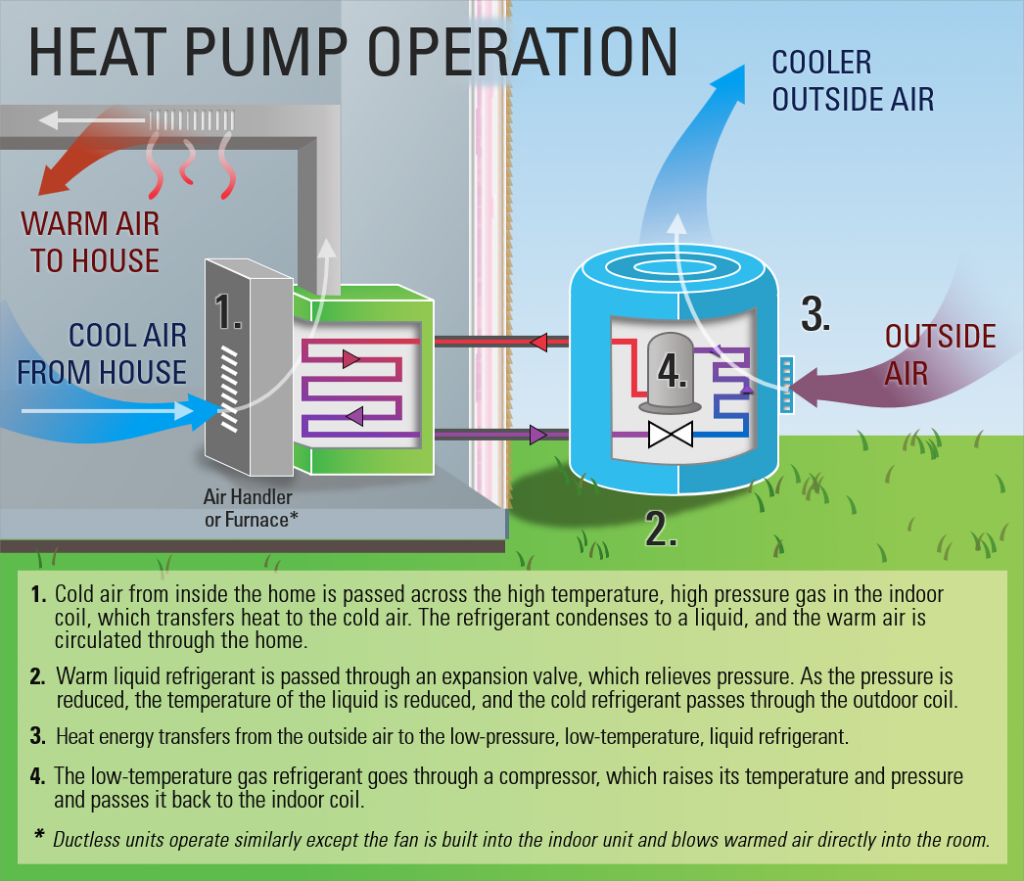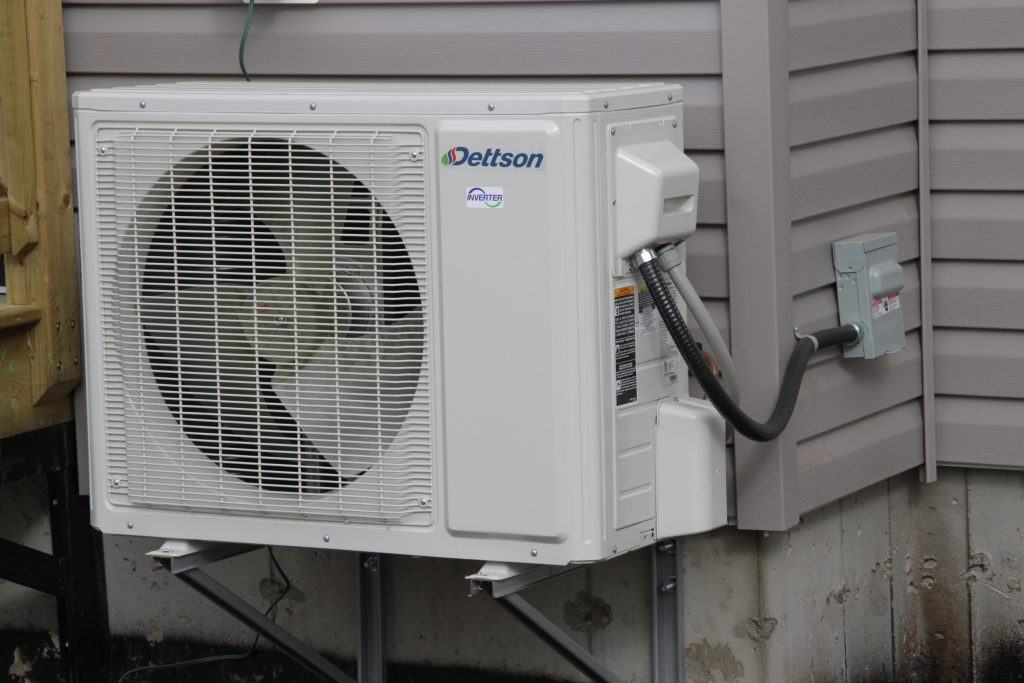By David Dodge, GreenEnergyFutures.ca
Heat pumps – it seems like you hear about them everywhere these days. In our story “Are Heat Pumps as Sexy and George Clooney” we met social science researcher Mike Fell from the UK who created a website called pumpchic.com to help promote heat pumps, a solution many say is essential to reducing emissions in home heating around the world.
In fact, many believe heat pumps are one of the only proven ways of eliminating greenhouse gas emissions from heating buildings, responsible for as much as 30% of of emissions.
But what is a heat pump and where can I use them in my home?
We sought out an expert to explain how they work and why they are such a good idea for heating our homes.

Jean-Marie Robert is a physicist and instructor who teaches students about geoexchange systems and high-performance buildings in the Alternative Energy Program at NAIT, a polytechnical institute in Edmonton, Alberta.
Heat pumps are not new, you already have heat pumps in your home if you have a fridge, freezer or air conditioner.
To explain how they work, Robert shows us a large model air source heat pump with an exploded view of the inner parts. (you can see this in our video above).
Essentially the air source heat pump has two parts, a unit that contains loops of copper pipes referred to as heat exchangers that goes outside the building.
And another unit that also contains heat exchanger piping that goes inside the building.
The pipes are connected and contain a refrigerant in a closed loop. In between the two units is a compressor and a metering device.
Heat just naturally wants to flow from hot to cold, hence it’s leaving your house all the time at rates that are determined by how much insulation you have and how well sealed your home is.

The Magical Mystery Part
Here’s where the magic happens. Robert says what we want to do is take heat out of the outside air and bring it inside. Let’s say the air is -10C outside and you want +20C inside.
To accomplish this we need to go against nature, which means your home heat just naturally wants to get out into the cold world.
So, the heat pump actually cools the refrigerant to temperatures as low as -30C before sending it to the outside heat exchanger.
This is where nature takes over. Since it’s a “balmy” -10C outside heat moves from the -10C air into the cold -30C refrigerant.
This warmed liquid then goes through the compressor which increases the pressure and thanks to physics the temperature of the fluid.
This fluid then goes into the heat exchanger pipes in your heat pump furnace at about 40 – 50C.
Here again nature takes over and the heat gravitates to the 20C air of your home to heat it.
Ok this is the simplified version, but that’s essentially how it works. Heat pumps do not make heat, they simply use temperature differentials and natural forces to move heat around.

Air Source Heat Pumps
In Canada we need to use cold climate heat pumps because for short periods in the winter we must deal with -30C outside air. Cold climate heat pumps work down to temperatures of -30. At this point their efficiency declines from 300 – 400% to as low as 100%, the same as a standard electric heater.
Some people have experienced problems with air source heat pumps that weren’t up to the task of working in our cold climate. In Canada heat pumps need to be able to handle wildly fluctuating outside temperatures that range from -30C to +40C
Many home builders who pioneered the idea of building net-zero super insulated homes in cold climates like Edmonton have used air source heat pumps for years, often with a backup heater for those cold periods. Well insulated net-zero homes require very little heat and air source heat pumps allow them to omit the natural gas hook up and the bills associated with it.
Cautionary note
As amazing as heat pumps are they can struggle to provide enough heat for a regular, poorly insulated home especially in cold climates. Although the cold climate air source heat pumps are rated to -30C they struggle in those temperatures and you may need back up heating for those times of the year. Be sure to have your home evaluated for its efficiency and heat loads before taking the leap.

Ground Source Heat Pumps
Ground source heat pump systems are quite a bit more expensive, but they are super reliable, and they extract heat from the Earth instead of the air which maintains relatively stable temperatures of between 0C and 6C. This is easy peasy for a heat pump.
Ground source heat pumps get their heat from the ground and are also called geoexchange systems or geothermal systems.

What can they do in my home?
Robert says the big advantage of heat pumps is they can do it all. A heat pump system can heat your home, provide hot water and with the simple flip of a switch the heat pump turns into an air conditioner, something Canadians are increasingly interested in as climate induced summer heat waves reach temperatures of nearly 50C in British Columbia and nearly 40C on the prairies.
By providing all of these services geoexchange systems which can cost $30,000 – $40,000 and more can still make sense economically. On new installs it really makes sense. You can avoid the cost of installing a gas line and there are no more gas bills.
The investment in heat pumps simply replaces what you would have spent on a standard furnace and hotwater heater.
Drilling to add 4-8 ground loops 120 meters deep costs money, but think of it as paying your utilities upfront, similar to a solar system.
Paybacks for these geoexchange systems are creeping down as low as 10 years in some cases which means you will be in the money for most of the life of the system.
Heat pump technology has come a long way but one of the challenges is getting good information when you go to buy a system. There are some very good installers emerging, but it’s still early days.
What about a cabin with mediocre insulation?
For example: I have a 1,000 square foot cabin that has 2×4 insulated walls, a crawl space and wood heating. Can I use an air source heat pump to maintain a minimum temperature of say 5C to keep my plumbing from freezing and then use wood to heat the cabin when I use it?
“Heat pumps come in all shapes and sizes for pretty much any application,” says Robert. “They do sell cold climate air source heat pumps which can run efficiently down to -30C.”
“And they even have a freeze protection mode which can be set such that it will monitor the temperature inside the space and kick in just to make sure that it’s above freezing,” says Robert.

Heat pumps are really starting to kick it
Heat pumps are not new. There are more than 100,000 geoexchange systems already installed in Canada. There are four big reasons heat pumps are coming into vogue today:
- Energy efficiency – in heating mode heat pumps are up to 400% efficient, so they require one quarter of the energy of an electric heater to provide the same amount of heat;
- Electrification – heat pumps allow us to ditch natural gas and the extra utility bill and they get their energy from electricity which can be provided by renewable energy such a solar to provide you with emissions free heating;
- Save money – Heat pumps will save you money over the long haul. After the high initial investment (ground source not air source heat pumps) you have no gas bill, high efficiency and in as little as ten years you are in the money;
- Green loans – with advent of rebates and green loan programs you can get a rebate on the system and a favourable loan such as Canada’s Greener Homes Loan so you are not paying any more than you are today for your heating, with the promise of dirt cheap energy after you reach payback period.
This means you can add solar, better insulate your home and add a heat pump and not be out of pocket.
In our quest to get to net-zero emissions heat pumps are one of the only current viable solutions for eliminating emissions from buildings.

The heat pump sweet spot
Geothermal companies are reporting rising demand for geoexchange systems in single family homes.
But it’s in slightly larger buildings such as multifamily buildings, office buildings and schools where heat pumps really shine.
Westmount Presbyterian Church partnered with the Right at Home Housing Society in Edmonton to build a 16-unit social housing complex and a new church that is entirely heated by a single geothermal system that replaces 16 gas utility hookups and bills. It is the first net-zero complex of its kind and it’s powered by solar energy.
The Salvation Army in Edmonton just built Grace Village, a 175-unit complex that uses geoexchange to heat the building. It was just a few percentage points more expensive to build the energy efficient building with geoexchange heating. They project they will save $240,000 per year on utility costs which amounts to $6 million over the life of the system.
Heating utility of the future
Blatchford, Canada’s largest planned carbon neutral community, has a district geoexchange system that has heat exchanger loops buried beneath a lake to heat an entire neighbourhood of homes with heat pumps.
The utility incumbents don’t seem to be embracing geoexchange yet, but they will.
Those same utilities already publicly admit there is no way to eliminate emissions from natural gas heating in buildings and that there is a time-limited future for it. Some are working on hydrogen as an alternative, but it’s still early days for this and there are many obstacles to overcome.
Geoexchange is already proven, the technology works great, and we it seems likely that it will become the primary method of heating buildings in the future.

